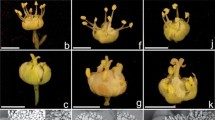Abstract
Some lines of one of the wild subspecies of cowpeas, Vigna unguiculata (L.) Walp. subspecies mensensis, which is characterized by large, conspicuous flowers, were found to set fruits poorly in the absence of a pollinator, whereas others, including cultivated lines, set well. These differences were related to the separation of anthers and stigma, the orientation of the stigmatic surface and the hairiness of the style, and differed from other outbreeding mechanisms reported in cowpeas. The results support division of wild cowpeas into two groups and suggest that an increase in the rate of inbreeding has accompanied their domestication.
Similar content being viewed by others
Literature Cited
Faris, D. G. 1965. The origin and evolution of the cultivated forms ofVigna sinensis. Canad. J. Genet. Cytol. 7: 433–452.
Harland, S. C. 1919. Inheritance of certain characters in the cowpea (Vigna sinensis). J. Genet. 8: 101–132.
Howlett, F. S. 1939. The modification of flower structure by environment in varieties ofLycopersicon esculentum. J. Agric. Res. 58: 79–117.
Piper, C. V. 1912. Agricultural varieties of the cowpea and immediately related species. U.S.D.A. Bur. PI. Industr. Bull. 229.
Purseglove, J. W. 1968. Tropical Crops. Dicotyledons. Longman, London.
Rachie, K. O., R. Rawal, J. D. Franckowiak, and M. A. Akinpelu. 1975. Two outcrossing mechanisms in cowpeas,Vigna unguiculata (L.) Walp. Euphytica 24: 159–163.
Rawal, K. M. 1975. Natural hybridization among wild, weedy and cultivatedVigna unguiculata (L.) Walp. Euphytica 24: 699–707.
-,K. O. Rachie, and J. D. Franckowiak. 1975. Reduction in seed size in crosses between wild and cultivatedVigna unguiculata (L.) Walp. Int. Inst. Tropical Agric. J. Series No. 50.
Rick, C. M., and W. H. Dempsey. 1969. Position of the stigma in relation to fruit setting of the tomato. Bot. Gaz. 130: 180–186.
Steele, W. M. 1972. Cowpeas in Nigeria. Ph.D. Thesis, Univ. Reading.
Stewart, K. A., and R. J. Summerfield. 1978. Effect of root temperature on floral morphology in cowpea(Vigna unguiculata (L.) Walp.) cv. K2809. PI. & Soil 49: 443–448.
Verdcourt, B. 1970. Studies in the Leguminosae-Papiliondideae for the “Flora of Tropical East Africa.” IV. Kew Bull. 24: 507–569.
Westphal, E. 1974. Pulses in Ethiopia, their Taxonomy and Agricultural Significance. Centre Agric. Publ., Wageningen.
Author information
Authors and Affiliations
Rights and permissions
About this article
Cite this article
Lush, W.M. Floral morphology of wild and cultivated cowpeas. Econ Bot 33, 442–447 (1979). https://doi.org/10.1007/BF02858340
Received:
Accepted:
Issue Date:
DOI: https://doi.org/10.1007/BF02858340




